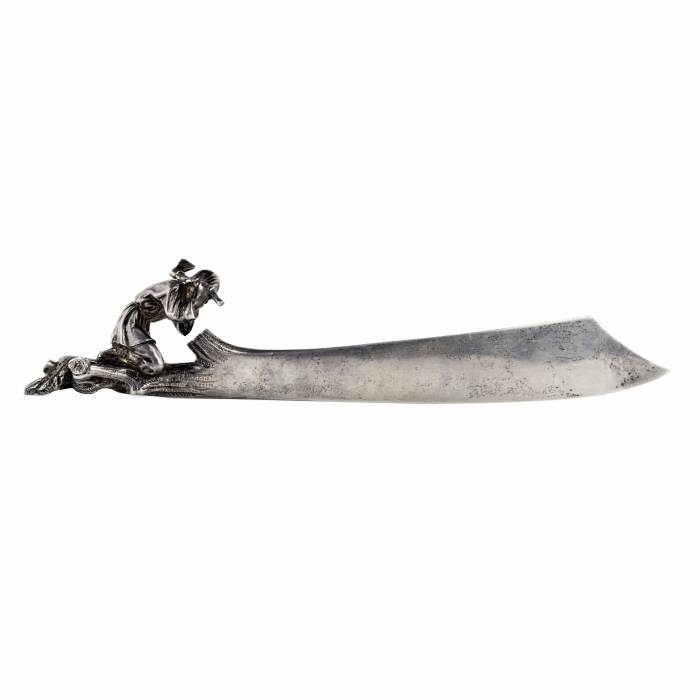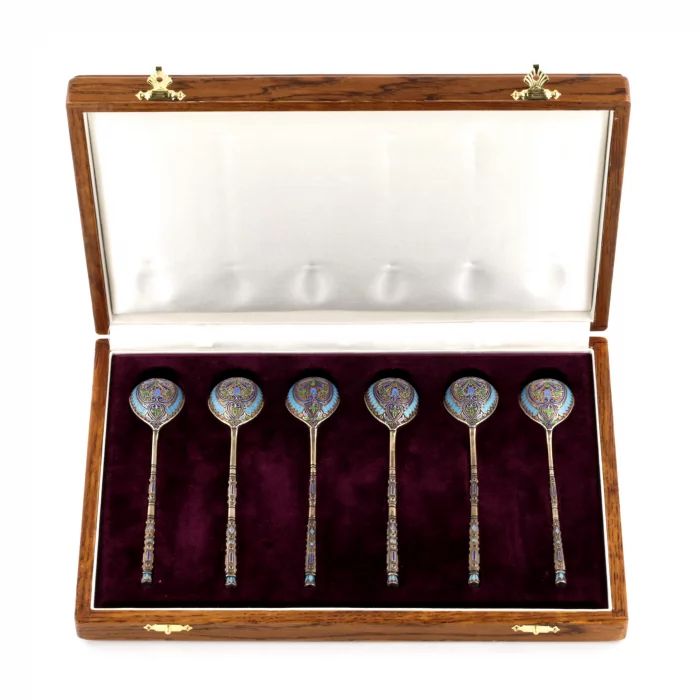
AntiqonART consultant will contact you within one business day after receiving your request.






















At Antiqon ART, we build trust and value your choice. Every purchase of art and antiques with us is an investment backed by our expertise, reputation, and a 100% authenticity guarantee.
Discover how the value of similar works has evolved over the past 10 years. Art is not only beauty — it's an investment.
Antiqon ART offers free packaging, insurance, and delivery for most items purchased through the company. Exceptions include large and oversized items that require specialized packing and shipping.
Poinçons : poinçon du maître DANNENBERG dans un cartouche ovale ; poinçon de linspecteur L.Z. / 1874 (Ludwig Zak) dans un cartouche carré ; poinçon de la chambre de contrôle de Riga représentant une porte fortifiée ; plusieurs poinçons de titre 84 zolotniks.
Dimensions : hauteur — 17 cm (avec le sommet — 22 cm) ; longueur dépliée — 29 cm ; pliée — 13,5 × 3,5 cm
Poids : 913 g
Expertise : expertise de Mikhaïl Itkine, spécialiste de lart décoratif et rituel juif du XVIIe au XXe siècle, auteur des ouvrages « Objets rituels juifs comme objets de collection » (2015), « Secret Beauty. Old Jewish Silver from Private Collection » (2021), « Judaica : symbolique de la décoration des objets rituels juifs » (2022).
Réputé pour ses objets rituels pour les églises luthériennes de Livonie, Dannenberg atteint ici un sommet de virtuosité joaillière, alliant maîtrise technique et compréhension profonde du symbolisme de la Judaïca.La lampe est composée de trois grandes plaques d’argent formant un triptyque pliant, richement décoré de symboles gravés et en relief. Une telle œuvre exige de la part du maître non seulement une maîtrise complète des techniques de bijouterie — gravure, ciselure, soudure, montage — mais aussi une pensée spatiale et une connaissance d’une iconographie étrangère à sa tradition.La structure pliante suggère une utilisation lors de voyages pendant la fête de Hanoucca. La composition ornementale comprend le portail du Temple de Jérusalem avec les colonnes du roi Salomon, un rouleau de la Torah ouvert avec sa Couronne, ainsi que les figures du prophète Moïse avec les Tables de la Loi, et du grand prêtre Aaron avec le pectoral et le shofar. L’ensemble est réalisé dans l’esthétique baroque caractéristique des hanoukiyot d’Europe orientale.
L’objet semble être une pièce unique. Aucune autre lampe de Hanoucca rigaise d’un tel niveau d’exécution et de conservation n’est actuellement connue. Cela fait de cet objet un témoignage unique de la tradition rituelle juive, d’une grande valeur historique, culturelle et de collection.
Des lampes comparables se trouvent dans les plus grandes collections mondiales : Musée d’Israël à Jérusalem, Jewish Museum à New York, Musée juif de Berlin. Mais son origine rigaise en fait une pièce d’une rareté absolue dans le patrimoine de la Judaïca balte.
État général — bon, avec une patine délicate et des signes naturels de vieillissement en accord avec sa période de création. Aucune perte, déformation ou intervention majeure signalée.Le rapport d’état est fourni à titre informatif uniquement. Il n’est pas exhaustif et peut ne pas refléter tous les défauts, restaurations ou modifications éventuelles. Antiqon ne fournit pas d’expertise de niveau conservateur. L’évaluation est subjective, bien que qualifiée. Avant tout achat, il est conseillé de consulter un expert indépendant. Veuillez également lire les conditions de participation aux enchères (Auction Rules) et le glossaire (Glossary).
The condition report is provided for informational purposes only.
It is not comprehensive and may not reflect all defects, restorations, alterations, or adaptations, as Antiqon does not perform professional conservation-level assessments. The information is based on a qualified, yet subjective, evaluation by our specialists.Before purchasing, we recommend consultation with an independent expert.Please also consult our Terms and conditions and Glossary A-Z, which contain important information on lot characteristics and sale conditions.

Thank you for your request!
Our consultant will contact you soon.

AntiqonART consultant will contact you within one business day after receiving your request.
Thank you for your request!
Our consultant will contact you soon.

AntiqonART consultant will contact you within one business day after receiving your request.
















